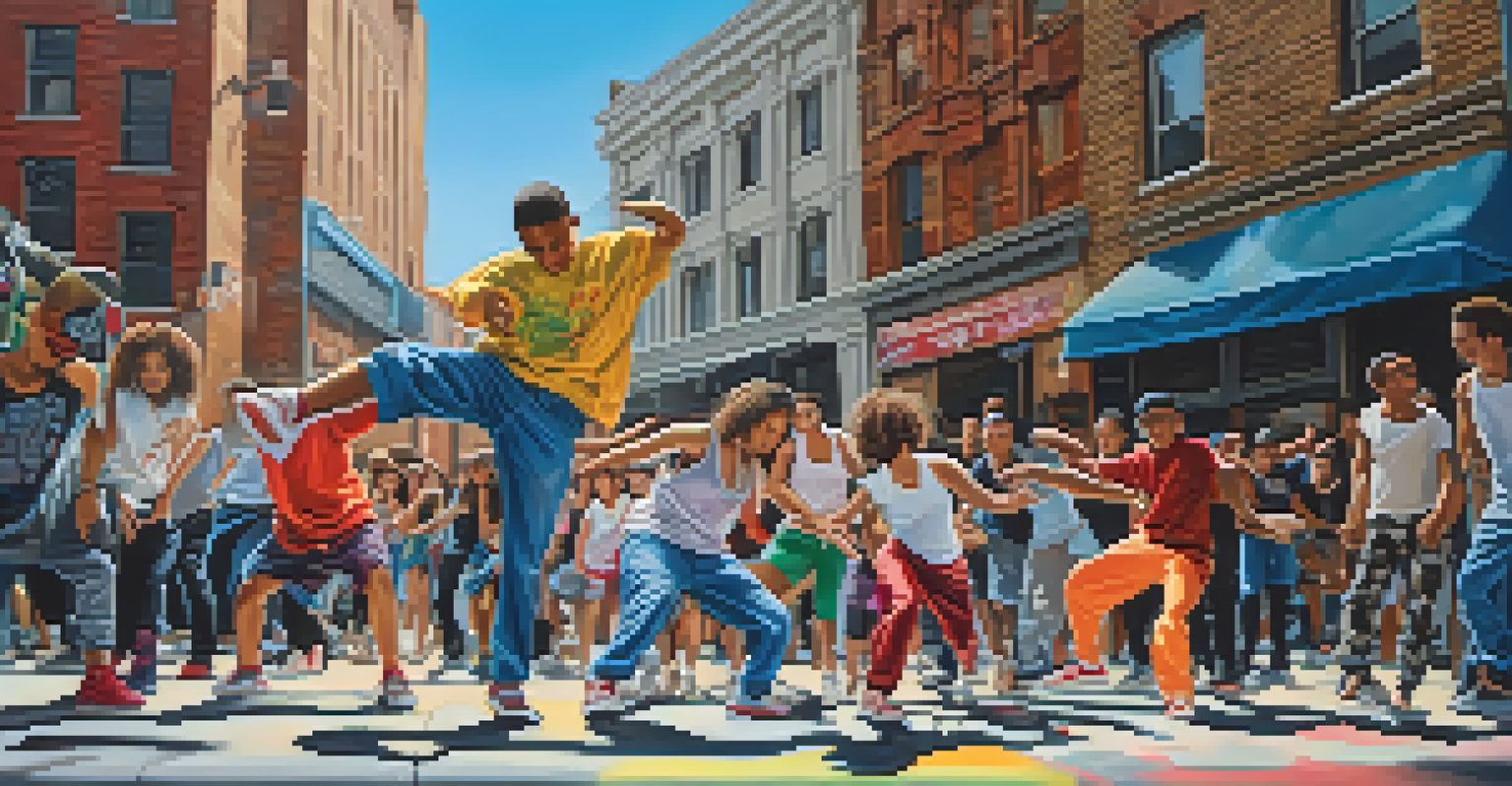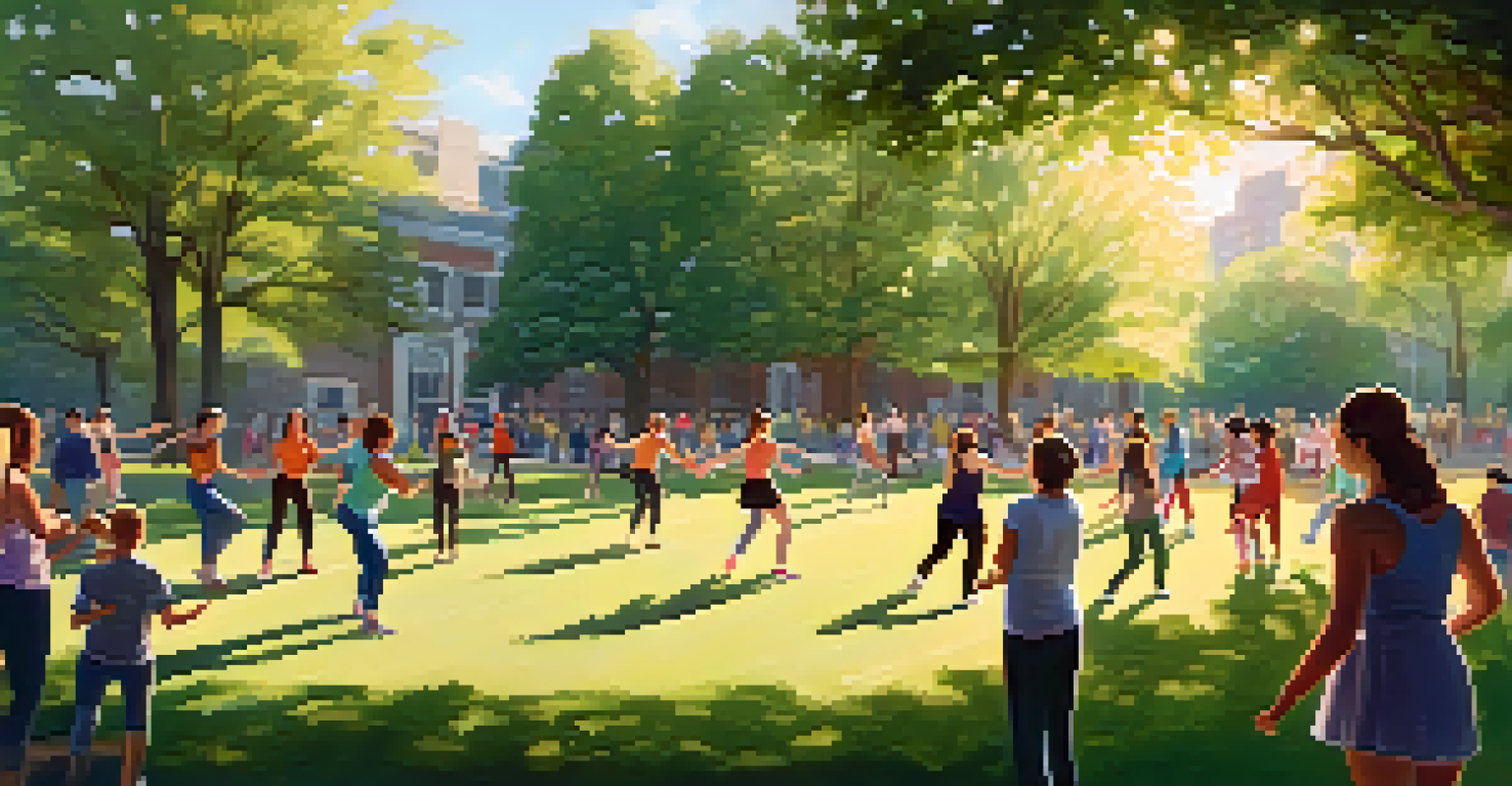Exploring the Historical Context of Dance in Public Spaces

The Origins of Dance in Public Spaces
Dance has been a part of human culture since ancient times, often serving as a communal activity that brings people together. In many early societies, dance was intertwined with rituals and celebrations, allowing communities to express their shared values and beliefs. For instance, in ancient Greece, public dances were integral to festivals honoring gods, showcasing both artistic expression and social cohesion.
Dance is the hidden language of the soul.
These early forms of dance were not merely entertainment; they represented a way to connect with the divine and with one another. As communities gathered in open spaces, the act of dancing became a communal language, transcending verbal communication. It established a sense of belonging and identity among participants, reinforcing social bonds.
Over the centuries, the significance of public dance has evolved, reflecting changes in culture, politics, and technology. However, the core idea of using dance as a means of social interaction remains a constant thread in its history.
Dance as a Tool for Social Change
Throughout history, dance has often been used as a powerful tool for social change. Movements such as the Civil Rights Movement in the United States saw dance become a form of protest and expression, with gatherings that combined music, dance, and activism. These public displays not only raised awareness but also fostered unity among participants, creating a rhythm that resonated with their cause.

Dance has the ability to convey messages and emotions that words alone cannot capture. For example, the dance styles that emerged from marginalized communities have often served as a means of reclaiming identity and culture. Public spaces became stages for showcasing these narratives, allowing dancers to voice their struggles and aspirations.
Dance Unites Communities
Throughout history, dance has served as a communal activity that fosters social bonds and a sense of belonging among participants.
In more recent times, social media has amplified this effect, enabling dance to become a global language for activism. Movements like Black Lives Matter have incorporated dance as a way to express solidarity and resilience, showcasing how public spaces can still be platforms for change.
The Role of Dance in Urban Environments
As cities have evolved, so too has the role of dance within urban environments. Public spaces such as parks, squares, and streets have become vital venues for impromptu dance gatherings, reflecting the dynamic nature of city life. Here, dancers transform ordinary locations into vibrant cultural hubs, inviting passersby to participate and engage.
The dance is a poem of which each movement is a word.
Urban dance scenes often emerge as expressions of local identity, showcasing the diverse influences that shape a city's culture. For instance, street dance styles like breakdancing gained prominence in the urban environments of the 1970s, serving as a creative outlet for youth and a means of self-expression. These gatherings not only promote artistic expression but also foster community spirit.
Moreover, public dance events like flash mobs or city-sponsored festivals have gained popularity, drawing people together in celebration of movement and creativity. Such events highlight how dance can be a unifying force, bridging gaps between different communities and fostering inclusivity.
Cultural Significance of Folk Dances
Folk dances hold a special place in the tapestry of public dance, representing the traditions and histories of various cultures. These dances, often passed down through generations, serve as a means of preserving cultural heritage while also providing opportunities for community engagement. Festivals featuring folk dances often attract participants and audiences alike, celebrating shared histories.
In many cultures, folk dances are performed during significant life events such as weddings, harvests, or religious ceremonies. These dances not only reflect the values and stories of a community but also reinforce social ties, as participants engage in shared rituals. For instance, the Maypole dance in Europe celebrates the arrival of spring, symbolizing renewal and community spirit.
Dance as a Change Catalyst
Dance has been a powerful tool for social change, allowing marginalized communities to express their identities and advocate for justice.
Despite the modern influences that challenge traditional practices, folk dances continue to thrive in public spaces, adapting to contemporary settings while retaining their cultural essence. This adaptability showcases the resilience of cultural traditions, ensuring they remain relevant and accessible.
Dance in Public Health Initiatives
In recent years, dance has been recognized for its benefits to public health, leading to initiatives that promote movement in community spaces. Programs that incorporate dance as a form of exercise not only enhance physical well-being but also foster social interaction. Community dance classes in parks or community centers provide an accessible avenue for individuals to engage in physical activity while enjoying the social aspect of group movement.
Research has shown that dance can significantly improve mental health, reducing stress and anxiety while enhancing overall mood. Public health campaigns have embraced dance as a way to encourage physical activity among diverse populations, emphasizing its inclusivity and ability to cater to different skill levels. This approach transforms public spaces into areas of wellness and connection.
Moreover, events like community dance nights or outdoor fitness classes create opportunities for people to come together, breaking down barriers and promoting a sense of community. As more cities recognize the importance of holistic well-being, the integration of dance into public health strategies continues to grow.
The Impact of Technology on Public Dance
The advent of technology has dramatically transformed the landscape of public dance, introducing new forms of interaction and participation. With the rise of social media platforms, dance challenges and viral trends have emerged, encouraging individuals to showcase their skills in public spaces. This digital influence has redefined how communities engage with dance, making it more accessible to a broader audience.
Technological advancements also enable dance performances to reach global audiences, transcending geographical boundaries. Live-streaming events, for example, allow dancers to share their work with viewers around the world, fostering a sense of global community. This interconnectedness highlights the role of public dance as a cultural exchange, where diverse styles and traditions can be celebrated.
Health Benefits of Dance
Public health initiatives are increasingly recognizing dance's role in promoting physical and mental well-being while enhancing community engagement.
However, technology also presents challenges, as it can create a divide between those who have access to resources and those who do not. As communities navigate this digital landscape, the challenge lies in ensuring that public spaces remain inclusive and welcoming for all forms of dance, regardless of technological proficiency.
The Future of Dance in Public Spaces
Looking ahead, the future of dance in public spaces is filled with exciting possibilities. As urban landscapes continue to evolve, there is a growing recognition of the importance of incorporating dance into community planning. More cities are beginning to design public spaces that encourage movement and interaction, from open-air stages to dedicated dance areas.
The integration of diverse dance forms into public life ensures that various cultural expressions are celebrated and preserved. Initiatives promoting inclusive dance practices can foster a sense of belonging among community members, regardless of their background. This commitment to diversity highlights the role of dance as a bridge between cultures, encouraging dialogue and understanding.

Ultimately, the future of dance in public spaces will depend on the collective efforts of communities, artists, and policymakers. By valuing dance as a vital component of urban life, society can create environments that not only celebrate movement but also strengthen community bonds, paving the way for a vibrant cultural future.